Charles Lennox, 4th Duke of Richmond
Charles Lennox, 4th Duke of Richmond, 4th Duke of Lennox, 4th Duke of Aubigny, KG, PC (9 December 1764 – 28 August 1819) was a Scottish peer, soldier, politician, and Governor General of British North America.
The Duke of Richmond and Lennox | |
|---|---|
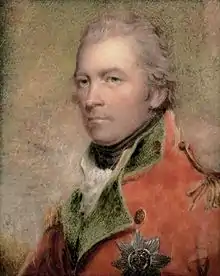 | |
| Lord Lieutenant of Ireland | |
| In office 11 April 1807 – 23 June 1813 | |
| Monarch | George III |
| Prime Minister | The Duke of Portland Hon. Spencer Perceval The Earl of Liverpool |
| Preceded by | The Duke of Bedford |
| Succeeded by | The Viscount Whitworth |
| Governor General of British North America | |
| In office 1818–1819 | |
| Monarch | George III |
| Preceded by | Sir John Coape Sherbrooke |
| Succeeded by | The Earl of Dalhousie |
| Personal details | |
| Born | 9 December 1764 Gordon Castle, Scotland |
| Died | 28 August 1819 (aged 54) Richmond, British North America |
| Nationality | Scottish |
| Political party | Tory |
| Spouse(s) | Lady Charlotte Gordon |
| Children | 14, including Charles, John, William, and Sussex |
| Parents | Lord George Lennox Lady Louisa Kerr |
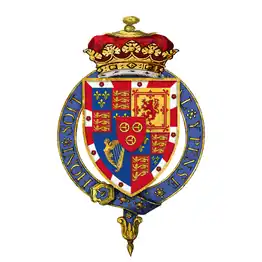
Background
Richmond was born to General Lord George Lennox, the younger son of Charles Lennox, 2nd Duke of Richmond, and Lady Louisa, daughter of William Kerr, 4th Marquess of Lothian. His aunts included the famous five Lennox sisters.
Cricket
Richmond was a keen cricketer. He was an accomplished right-hand bat and a noted wicket-keeper. An amateur, he was a founder member of the Marylebone Cricket Club. In 1786, together with the Earl of Winchilsea, Richmond offered Thomas Lord a guarantee against any losses Lord might suffer on starting a new cricket ground. This led to Lord opening his first cricket ground in 1787. Although Lord's Cricket Ground has since moved twice, Richmond and Winchilsea's guarantee provided the genesis of the best-known cricket ground in the world, a ground known as the Home of Cricket. Nearly always listed as the Hon. Colonel Charles Lennox in contemporary scorecards, Richmond had 55 recorded first-class appearances from 1784 to 1800 and played a few more games after that.
Army general
Richmond became a British Army captain at the age of 23 in 1787. On 27 May 1789, while a colonel in the Duke of York's regiment, he was involved in a duel with Frederick, Duke of York, who had expressed the opinion that "Colonel Lennox had heard words spoken to him at Daughbigny's, to which no gentleman ought to have submitted", effectively an accusation of failing to respond to an insult in the way that a gentleman should. At Wimbledon Common, Richmond fired, but his ball "grazed his Royal Highness's curl"; the Duke did not fire.[1] Richmond shortly after exchanged his company for the commission of a lieutenant-colonel in the 35th Regiment of Foot.[2] On 1 July of the same year, he was involved in another duel, with Theophilus Swift, Esq., in consequence of a pamphlet criticising Richmond's character published under Swift's name. They met in a field near the Uxbridge Road, where Swift was wounded in the body, but recovered.[3]
%252C_by_Joseph_Nollekens.jpg.webp)
Later in the year he married Lady Charlotte Gordon. In 1794 and 1795 he participated in naval engagements against the French in the West Indies and Gibraltar, but was sent home when he came into conflict with his superiors. He was also MP for Sussex, succeeding his father, from 1790 until he succeeded to the dukedom.
Duke
He became the 4th Duke of Richmond on 29 December 1806, after the death of his uncle, Charles Lennox, 3rd Duke of Richmond. In April 1807 he became Lord Lieutenant of Ireland. He remained in that post until 1813. He participated in the Napoleonic Wars and in 1815 he was in command of a reserve force in Brussels, which was protecting that city in case Napoleon won the Battle of Waterloo. On 15 June, the night before the Battle of Quatre Bras, his wife held a ball for his fellow officers. The glittering celebration became famous as the Duchess of Richmond's ball and was immortalised by William Makepeace Thackeray in Vanity Fair and by Lord Byron in Childe Harold's Pilgrimage.
Although the Duke observed the Battle of Quatre Bras the next day, as well as Waterloo on 18 June, he did not participate in either.
Governor General of Canada
In 1818 he was appointed Governor General of British North America.
During summer 1819, Richmond was undertaking a tour of Upper and Lower Canada, when he was bitten on the hand by a fox. The injury apparently healed and he continued on the tour, but later in his journey the initial symptoms of hydrophobia appeared. After the disease had developed rapidly, he died 28 August. Richmond's body was returned to Quebec, where he was buried at the Cathedral of the Holy Trinity on 4 September.[4]
The night before his death, he slept at the "Masonic Arms", which was renamed the "Duke of Richmond Arms" to commemorate the visit.
Richmond's title was inherited by his son, Charles Gordon-Lennox, 5th Duke of Richmond.
Legacy
Richmond County, Nova Scotia; Richmond, Ontario; March Township, Ontario; Huntley Township, Ontario; Torbolton Township, Ontario; Fitzroy Township, Ontario; Earl of March Secondary School; Lennoxville, Quebec; Richmond, Quebec; and Richmond County, Nova Scotia; along with Richmond Street in Toronto, Ontario, and Richmond Street in London, Ontario,[5] were named after him. According to tradition, the town of Richmond Hill, Ontario, was also named after him, as he was said to have passed through the then village during his visit in 1819.
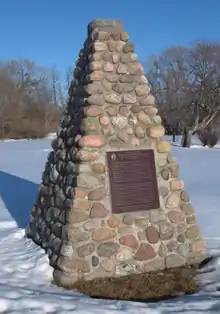
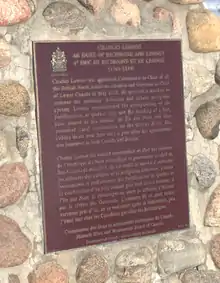
Richmond Park (football ground) in Inchicore, Dublin, still bears his name. Now the home ground of St. Patrick's Athletic Football Club, it was once a part of Richmond Barracks as Richmond was Lord Lieutenant of Ireland (1807–1813). It was to these barracks that over 3,000 prisoners were brought after the 1916 Easter Rising in Dublin. After independence the barracks were renamed Keogh Barracks and later were redeveloped as housing for the capital's poor and again renamed Keogh Square.
Children
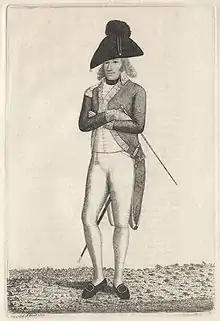
Richmond had fourteen children:
- Lady Mary Lennox (15 August 1790 – 7 December 1847), married Sir Charles Fitzroy and had issue.
- Charles Gordon-Lennox, 5th Duke of Richmond (3 August 1791 – 21 October 1860).
- Lt.-Col. Lord John George Lennox (3 October 1793 – 10 November 1873), married Louisa Rodney and had issue.
- Lady Sarah Lennox (c. 1794 – 8 September 1873), married Peregrine Maitland.
- Lady Georgiana Lennox (30 September 1795 – 15 December 1891), married William FitzGerald-de Ros, 23rd Baron de Ros, and had issue.
- Lord Henry Adam Lennox (6 September 1797 – 1812), fell overboard from HMS Blake and drowned.
- Lord William Lennox (20 September 1799 – 18 February 1881), married first Mary Ann Paton and second Ellen Smith; had issue by the latter.
- Lady Jane Lennox (c. 1800 – 27 March 1861), married Laurence Peel and had issue.
- Captain Lord Frederick Lennox (24 January 1801 – 25 October 1829).
- Lord Sussex Lennox (11 June 1802 – 12 April 1874), married Hon. Mary Lawless and had issue.
- Lady Louisa Maddelena Lennox (2 October 1803 – 2 March 1900), married Rt. Hon. William Tighe, died without issue.
- Lady Charlotte Lennox (c. 1804 – 20 August 1833), married Maurice Berkeley, 1st Baron FitzHardinge of Bristol, and had issue.
- Lt.-Col. Lord Arthur Lennox (2 October 1806 – 15 January 1864), married Adelaide Campbell and had issue.
- Lady Sophia Georgiana Lennox (21 July 1809 – 17 January 1902), married Lord Thomas Cecil, died without issue.
References
Notes
- Millingen, pp. 131–32.
- Millingen, p. 133.
- Millingen, p. 135.
- Stanley, George F.G. (1983). "LENNOX, CHARLES, 4th Duke of RICHMOND and LENNOX". Dictionary of Canadian Biography. 5. Toronto: University of Toronto/Université Laval.
- Priddis, Harriet (1909). The Naming of London Streets: Read before the London and Middlesex Historical Society, May 16th, 1905. Revised and corrected up to date, January 9th, 1909. London, ON: London and Middlesex Historical Society. pp. 10.
Bibliography
- Harry Altham, A History of Cricket, Volume 1 (to 1914), George Allen & Unwin, 1962.
- Derek Birley, A Social History of English Cricket, Aurum, 1999.
- Rowland Bowen, Cricket: A History of its Growth and Development, Eyre & Spottiswoode, 1970.
- G. B. Buckley, Fresh Light on 18th Century Cricket, Cotterell, 1935.
- Arthur Haygarth, Scores & Biographies, Volume 1 (1744–1826), Lillywhite, 1862.
- J. G. Millingen, The History of Duelling, Volume 2, London: Richard Bentley, 1841.
- John Nyren, The Cricketers of my Time (ed. Ashley Mote), Robson, 1998.
- David Underdown, Start of Play, Allen Lane, 2000.
- H. T. Waghorn, The Dawn of Cricket, Electric Press, 1906.
- Bill Wasik and Monica Murphy, Rabid: A Cultural History of the World's Most Diabolical Virus, Penguin Group, 2012
- Eric Arthur, Toronto, No Mean City (Third Edition, rev. and ed. Stephen A. Otto), University of Toronto Press, 1986.
- Lord's 1787–1945 by Sir Pelham Warner ISBN 1-85145-112-9.
- Woods, Shirley E. Jr. Ottawa: The Capital of Canada, Toronto: Doubleday Canada, 1980. ISBN 0-385-14722-8.
External links
- Biography at the Dictionary of Canadian Biography Online
- Cricket Archive page on Charles Lennox
- Cricinfo page on Charles Lennox
- Journey To Nationhood, 150 Years in Canada's Capital